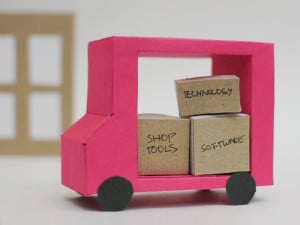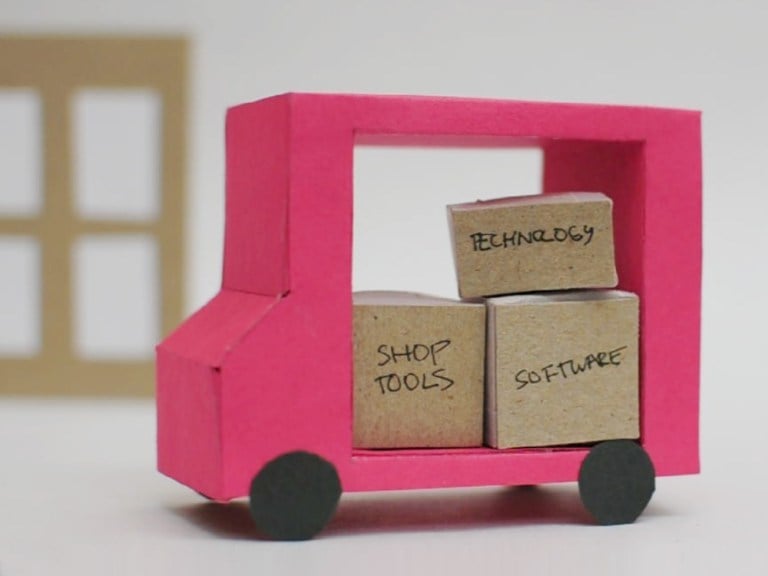In a crowded garage at the Hasso Plattner Institute of Design at Stanford (d.school), a group of students lounge on red couches, fiddle with Legos and rethink education. The students’ plan is straightforward: Buy a red truck, fill it with tools and drive it to schools. The team — Jason Chua ’11 M.S. ’12, Prat Ganapathy M.S. ’12, Kathayoon Khalil Ph.D. ’14, Eugene Korsunskiy M.F.A. ’12, Diane Lee ’12 and Aaron Peck ’12 — calls itself SparkLab and hopes to deliver hands-on learning to Bay Area students.

SparkLab was developed as part of a mechanical engineering class known informally as “Design Garage.” Other teams in the class are tackling projects rethinking journalism and redesigning the wheelchair. The teams are advised by prominent figures, such as IDEO founder David Kelly.
“Our whole point is that manipulating matter with your hands is how you get a sense of empowerment that you can change the world around you,” Korsunskiy said of his team’s vision.
Korsunskiy said he realized, reflecting on his own experience in school, that “tinkering opportunities” tended to diminish as he advanced through the grade levels. The team saw a problem with hands-on work in the current education system.
“There’s a lot of high-level education policymakers who in theory claim to agree that the future of the country depends on a workforce that’s creative…but no one’s doing anything about it,” Korsunskiy said. “As [they]’re talking about how creativity needs to be expanded, shop classes are being cut…so we decided: ‘We are going to do something about this.’”
When the SparkLab team talked to working teachers, they learned that many lacked the time and space to emphasize creativity in the classroom.
“We came up with the idea that maybe we can be this mobile-tinkering field trip that comes to you,” Korsunskiy said.
SparkLab plans to target middle school students initially. Inside the truck, the team will guide students through the process of creating their own product.
Take the example of middle school students building a homemade lamp. First, they would choose their favorite lamp designs. Then, they would create a rough version using materials such as Popsicle sticks and twist ties before building a clay prototype. At that point, the SparkLab team would use software called Autodesk 123D to photograph the clay prototype from multiple angles, generating a three-dimensional model of the lamp. Finally, a 3D printer would spit out layers of hot glue to produce a physical copy of the lamp.
While the technology itself is impressive, “the most important part is for kids to have an artifact that they can take home and show their parents,” Peck said.
The SparkLab team also aims to balance the expensive tools with plenty of low-tech items of the sort that might be found in a shop class.
The truck’s physical location outside of schools is key to the project’s effectiveness. Khalil described the classroom as a “psychological barrier” for some kids.
“It’s not just a physical, outside space, it’s psychological space,” Chua said. “Once students step out of the classroom, it frees them to be more creative.”
Unlike a conventional startup, SparkLab does not expect to generate any revenue. Instead, the project will rely on funding from an online Kickstarter campaign — thus far, SparkLab has raised over $7,500 toward a target of $25,000. Team members hope to persuade tool companies to donate expensive items such as laser cutters or 3D printers.
Despite its promise, SparkLab faces some obstacles. With $25,000, the team would only be able to afford a single truck, limiting the number of students who could benefit from the project. However, as Chua emphasized, “right now, we’re concentrating on focused impact, rather than super-scaled impact.”
In this stage of their project, the SparkLab team has also been busy holding workshops and attending interviews, and they’ve found it hard to find time for introspection, according to Korsunskiy. Nevertheless, the SparkLab team has been able to meet important Bay Area contacts at events such as Maker Faire, a two-day festival celebrating creativity and hands-on making.
“It seems like we’ve struck a nerve somewhere, where this idea resonates with a lot of people,” Chua said.
Among other local figures, the group met the founder of Make, a magazine focused on do-it-yourself (DIY) projects, as well as officials from the San Francisco Exploratorium, design software company Autodesk and San Jose-based nonprofit Resource Area For Teaching (RAFT). Responses to the project have been positive.
“This is an incredibly cool idea — getting these tools into the hands of kids!” wrote Carl Bass, CEO of Autodesk, on SparkLab’s Kickstarter page.
“I love the truck. This is a great way to bring the tools and materials for making to more young makers,” wrote Dale Dougherty, founding editor of MAKE magazine, on the same page.
The SparkLab team tested out their idea on campus last year by running design workshops at Splash!, a program that brings middle school, high school and underserved students to Stanford’s campus for two days. Working with sixth graders and Yahoo! executives, the team was surprised to find that the younger students were more creative.
“It’s really sad to see what happens between those ages that really squashes any semblance of fearless, creative endeavors,” Korsunskiy said.
With a hectic schedule, the team members say that it is important to beat stress and maintain their enthusiasm. Their team dynamic reflects this ethos.
“We believe that the team that has the most fun together comes up with the best ideas,” Korsunskiy said.
“We basically spend our waking lives together, so we’d better have fun, or our lives will suck,” Chua added. “Some of us are to the point where we communicate in blinks and grunts.”
Despite all the support, developing a unique education project has not been easy.
“Every person has an opinion on education…We have trouble figuring out what’s new,” Khalil said. “But we decided, it doesn’t matter if the solution is new — the problems are still here, and they don’t go away.”
